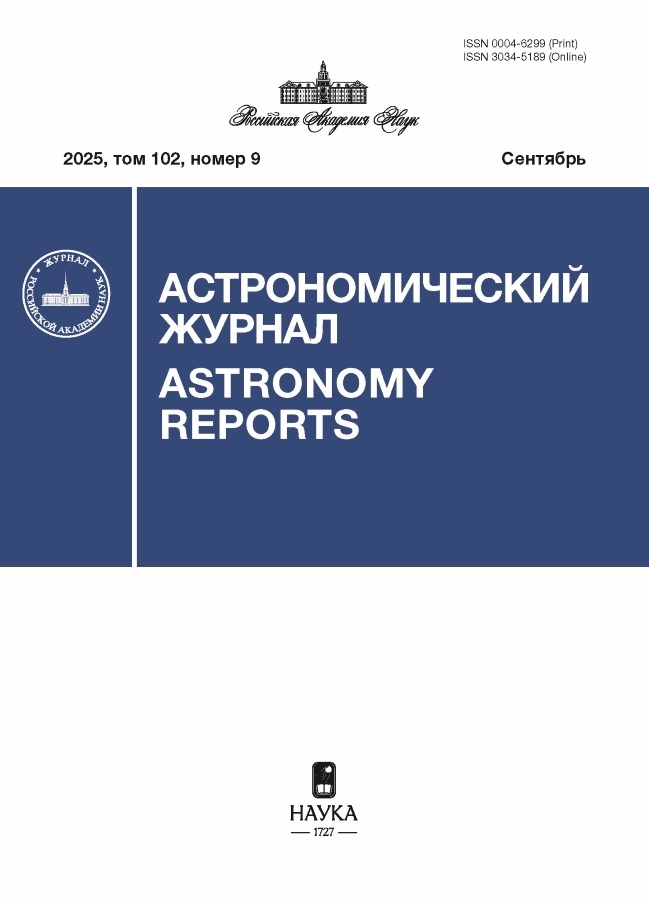Characteristics of Super-Earths and Mini-Neptunes
- Authors: Morozov G.A.1,2, Belenkaya E.S.2
-
Affiliations:
- Lomonosov Moscow State University, Faculty of Physics
- Lomonosov Moscow State University, Skobeltsyn Institute of Nuclear Physics
- Issue: Vol 102, No 9 (2025)
- Pages: 774-779
- Section: Articles
- URL: https://rjmseer.com/0004-6299/article/view/695911
- DOI: https://doi.org/10.31857/S0004629925090031
- ID: 695911
Cite item
Abstract
More than half of currently known stars have nearby exoplanets with size between Earth and Neptune, called super-Earths and mini-Neptunes. The California-Kepler Survey (CKS) studied data from NASA’s Kepler mission and revealed a bimodal distribution of planets with by radius ( is the radius of the Earth). It occured that there was a lack of planets with radii . The CKS did not take into account data from other missions and exoplanets discovered by non-transit methods. All data from this mission were limited to 2022. This article examines the distribution of super-Earths and mini-Neptunes, taking into account all data on exoplanets known by 2024 from the NASA catalog. Mini-Neptunes and super-Earths with known radii were selected. There were 937 such planets, including 366 planets with known mass. Since the radius of a planet can only be determined by the transit method, the distribution by radii is built using the data of transit planets, but, unlike CKS, not only the data of the Kepler mission are taken. The data for the remaining distributions are selected regardless of the method of their detection and the telescope used. We show that the current data are best fitted by a double-peaked Gaussian distribution, which describes two populations of planets: rocky (hereinafter super-Earths) and exoplanets with gas envelopes (exoplanets surrounded by hydrogen-helium atmospheres, but consisting mainly of heavy elements — ice and rock, hereinafter mini-Neptunes). The magnitude of the gap between populations at present is analyzed. It is shown that the gap is filled evenly on both sides; in CKS, the first peak is significantly smaller than the second, that is, there were fewer super-Earths than mini-Neptunes. Perhaps more super-Earths have been discovered recently, which is why there was a shortage of them in the CKS. The composition of some exoplanets was determined using theoretical models of the dependence of mass on radius.
Keywords
About the authors
G. A. Morozov
Lomonosov Moscow State University, Faculty of Physics; Lomonosov Moscow State University, Skobeltsyn Institute of Nuclear Physics
Email: morozov.ga21@physics.msu.ru
Moscow, Russia; Moscow, Russia
E. S. Belenkaya
Lomonosov Moscow State University, Skobeltsyn Institute of Nuclear PhysicsMoscow, Russia
References
- B.J. Fulton and E.A. Petigura, Astron. J. 156, 264 (2018).
- G. D’Angelo and J.J. Lissauer, in Handbook of Exoplanets, edited by H.J. Deeg and J.A. Belmonte (Springer Intern. Publ., 2018) p. 2319.
- B. Bitsch and A. Izidoro, Astron. and Astrophys. 674, id. A178 (2023).
- A. Izidoro, B. Bitsch, S.N. Raymond, Y. Alibert, C. Mordasini, and A. Johansen, Astron. and Astrophys. 650, id. A152 (2021).
- C. Sotin, O. Grasset, and A. Mocquet, Icarus 191(1), 337 (2007).
- G.W. Marcy, H. Isaacson, A.W. Howard, J.F. Rowe, et al., Suppl. 210(2), id. 20 (2014).
Supplementary files










